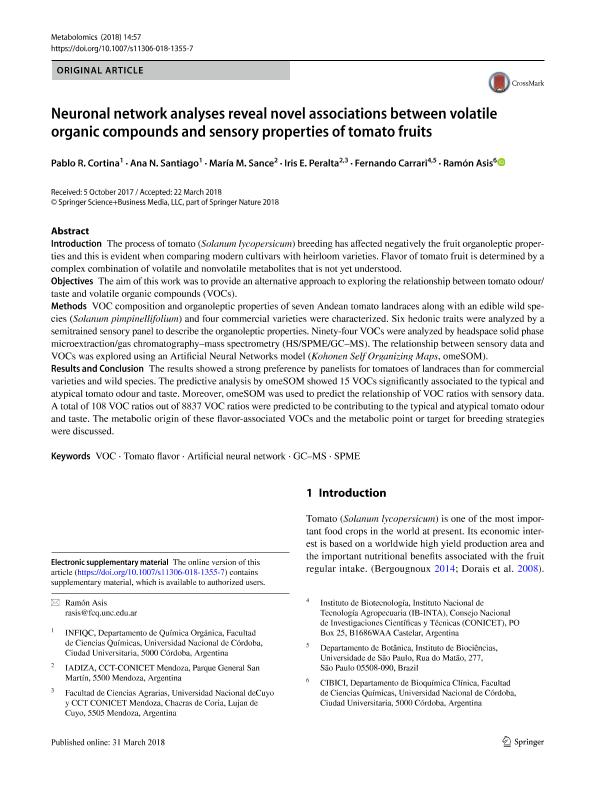Artículo
Neuronal network analyses reveal novel associations between volatile organic compounds and sensory properties of tomato fruits
Cortina, Pablo Ramiro ; Santiago, Ana Noemi
; Santiago, Ana Noemi ; Sance, Maria Mirta
; Sance, Maria Mirta ; Peralta, Iris Edith
; Peralta, Iris Edith ; Carrari, Fernando Oscar
; Carrari, Fernando Oscar ; Asis, Ramón
; Asis, Ramón
 ; Santiago, Ana Noemi
; Santiago, Ana Noemi ; Sance, Maria Mirta
; Sance, Maria Mirta ; Peralta, Iris Edith
; Peralta, Iris Edith ; Carrari, Fernando Oscar
; Carrari, Fernando Oscar ; Asis, Ramón
; Asis, Ramón
Fecha de publicación:
05/2018
Editorial:
Springer
Revista:
Metabolomics
ISSN:
1573-3882
Idioma:
Inglés
Tipo de recurso:
Artículo publicado
Clasificación temática:
Resumen
The process of tomato (Solanum lycopersicum) breeding has affected negatively the fruit organoleptic properties and this is evident when comparing modern cultivars with heirloom varieties. Flavor of tomato fruit is determined by a complex combination of volatile and nonvolatile metabolites that is not yet understood. Objectives: The aim of this work was to provide an alternative approach to exploring the relationship between tomato odour/taste and volatile organic compounds (VOCs). VOC composition and organoleptic properties of seven Andean tomato landraces along with an edible wild species (Solanum pimpinellifolium) and four commercial varieties were characterized. Six hedonic traits were analyzed by a semitrained sensory panel to describe the organoleptic properties. Ninety-four VOCs were analyzed by headspace solid phase microextraction/gas chromatography–mass spectrometry (HS/SPME/GC–MS). The relationship between sensory data and VOCs was explored using an Artificial Neural Networks model (Kohonen Self Organizing Maps, omeSOM). The results showed a strong preference by panelists for tomatoes of landraces than for commercial varieties and wild species. The predictive analysis by omeSOM showed 15 VOCs significantly associated to the typical and atypical tomato odour and taste. Moreover, omeSOM was used to predict the relationship of VOC ratios with sensory data. A total of 108 VOC ratios out of 8837 VOC ratios were predicted to be contributing to the typical and atypical tomato odour and taste. The metabolic origin of these flavor-associated VOCs and the metabolic point or target for breeding strategies were discussed.
Palabras clave:
ARTIFICIAL NEURAL NETWORK
,
GC–MS
,
SPME
,
TOMATO FLAVOR
,
VOC
Archivos asociados
Licencia
Identificadores
Colecciones
Articulos(CIBICI)
Articulos de CENTRO DE INV.EN BIOQUI.CLINICA E INMUNOLOGIA
Articulos de CENTRO DE INV.EN BIOQUI.CLINICA E INMUNOLOGIA
Articulos(IADIZA)
Articulos de INST. ARG DE INVEST. DE LAS ZONAS ARIDAS
Articulos de INST. ARG DE INVEST. DE LAS ZONAS ARIDAS
Articulos(IMBIV)
Articulos de INST.MULTIDISCIPL.DE BIOLOGIA VEGETAL (P)
Articulos de INST.MULTIDISCIPL.DE BIOLOGIA VEGETAL (P)
Articulos(INFIQC)
Articulos de INST.DE INVESTIGACIONES EN FISICO- QUIMICA DE CORDOBA
Articulos de INST.DE INVESTIGACIONES EN FISICO- QUIMICA DE CORDOBA
Articulos(SEDE CENTRAL)
Articulos de SEDE CENTRAL
Articulos de SEDE CENTRAL
Citación
Cortina, Pablo Ramiro; Santiago, Ana Noemi; Sance, Maria Mirta; Peralta, Iris Edith; Carrari, Fernando Oscar; et al.; Neuronal network analyses reveal novel associations between volatile organic compounds and sensory properties of tomato fruits; Springer; Metabolomics; 14; 5; 5-2018
Compartir
Altmétricas



